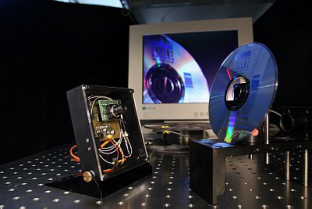Dr. Elisabeth Zuber-Knost Kaiserstraße 12 | |
|
Researchers of the Universität Karlsruhe have developed a camera network that operates with light instead of electricity and needs a minimum of energy only. At the European Conference on Optical Communications (ECOC), the group of Professor Jürg Leuthold and Professor Jürgen Becker presented this innovation that is of particular interest to applications in safety technology. |
For details, please contact: Press and Communication Phone: +49 721 608-8126 |
|
At first glance, you might believe that it is a normal video camera supplying 15 colored images of VGA resolution (640 x 480 pixels) per second. At second glance, however, the self-made video camera is supplied neither via a battery nor by an accumulator or electricity cable. The only thing that connects the camera with the base is a glass fiber cable of 200 m length that is as thin as a hair. It can transmit several signals at the same time at variable wavelengths. One wavelength serves to supply the camera with energy. The other wavelength is for data communication and used to send the image signal back to the base. And the camera saves energy: In total, it only consumes 100 milliwatts for the CMOS sensor (40 mW), the electronics (40 mW), and the transmission laser (20 mW) in order to transmit the video data of 100 megabits per second to the base. This is done at a wavelength of 1310 nm. With a light signal of 400 mW and a wavelength of 810 nm, the video camera is provided with the energy required. A photodiode converts the light into electric current. Both data channels are bundled in a 62.5 µm standard multi-mode fiber. At the base, a computer receives the image signal and transmits the images to the internet. Development of this purely optically operated camera network was real teamwork, explains Professor Leuthold. Under the direction of Professor Becker, the Institute for Information Processing Technology contributed the electronics. The highly sensitive photodiode for the conversion of laser light into electrical energy was developed by the Fraunhofer Institute for Solar Energy Systems in Freiburg. The Institute for High-Frequency Technology and Quantum Electronics headed by Professor Leuthold and Professor Wolfgang Freude was responsible for the optical communication technology. Recently, the team presented this innovation at the “European Conference on Optical Communications” (ECOC) in Berlin to roundabout 1200 scientists and engineers from 60 countries. This conference that takes place at different locations each year is the largest conference on optical communication technology in Europe and considered to be one of the two most important conferences in this field. Only selected work representing the latest state of art may be presented. As pointed out by Professor Leuthold, the light-fed camera network is of particular interest to applications in safety technology, especially when rooms are to be backfitted with video cameras. “Instead of opening the walls to lay electric cables, you only need to fix hair-fine glass fiber cables. When painted, they are no longer visible.” This optical energy supply is also suited for use in environments with strong interfering electromagnetic fields or a high risk of explosion. The Karlsruhe Institute of Technology (KIT) represents the merger of the Universität Karlsruhe with the Forschungszentrum Karlsruhe. Altogether, it has 8000 employees and an annual budget of 600 million Euros. In the KIT, both partners are bundling their scientific competences and capacities, establishing optimum research structures, and developing joint strategies and visions. The KIT will be an institution of internationally excellent research and lecturing in natural and engineering sciences. KIT shall attract the best experts from all over the world, set new standards in lecturing and promotion of young scientists, and establish the leading European center in the field of energy research. KIT will assume a leading role in nanosciences worldwide. It is the objective of KIT to be one of the most important cooperation partners of industry. | |
Press Release 12/2007
Nothing, but Light
KIT Researchers Develop an Optically Operated Camera Network

The video camera (left) is linked to a PC via a glass fiber. The camera needs neither an accumulator nor does it have to be connected to the grid.
lg, October 18, 2007
Contact:
Christian Könemann
Chief Press Officer
Phone: +49 721 608-41190
Fax: +49 721 608-43658
christian koenemann ∂does-not-exist.kit edu
Contact for this press release:
Monika Landgraf
Press Officer
Phone: +49 721 608-21150
Fax: +49 721 608-41150
monika landgraf ∂does-not-exist.kit edu
Press Officer
Phone: +49 721 608-21150
Fax: +49 721 608-41150
monika landgraf ∂does-not-exist.kit edu
